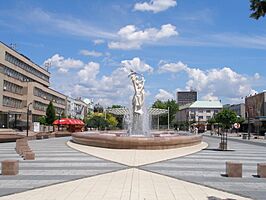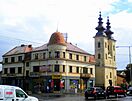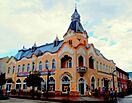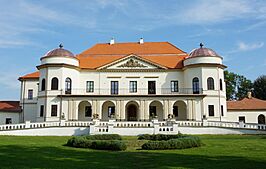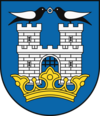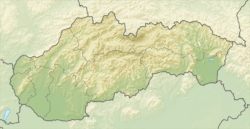Michalovce facts for kids
Quick facts for kids
Michalovce
|
|||
|---|---|---|---|
|
Town
|
|||
|
|||
| Etymology: St Michael | |||
| Country | |||
| Region | Košice | ||
| First mentioned | 1244 | ||
| Area | |||
| • Total | 52.81 km2 (20.39 sq mi) | ||
| (2022) | |||
| Elevation | 113 m (371 ft) | ||
| Population
(2022)
|
|||
| • Total | 35,874 | ||
| • Density | 679.30/km2 (1,759.39/sq mi) | ||
| Time zone | UTC+1 (CET) | ||
| • Summer (DST) | UTC+2 (CEST) | ||
| Postal code |
071 01
|
||
| Area code(s) | +421 56 | ||
| Car plate | MI | ||
| Website | http://www.michalovce.sk | ||
Michalovce is a town located on the Laborec river in eastern Slovakia. It was named after the Archangel St Michael. It is the second-largest city in the Košice Region. Michalovce is also the main town of the Michalovce District.
The town sits near Lake Sirava. It is about 360 kilometers (224 miles) east of Bratislava, the capital city. Michalovce is also very close to the border with Ukraine. The area is known for its beautiful lakes and volcanic mountains. These natural features help bring in tourism. The town is also important for agriculture and has the Druzhba pipeline passing through it. About 40,000 people live in Michalovce, making it one of the biggest towns in eastern Slovakia.
Contents
History of Michalovce
Early Times in Michalovce
The area where Michalovce is today has been settled for a very long time. People lived here since the Palaeolithic era, which was the Old Stone Age. Archaeologists have found ancient human skeletons in the region. They also found many old tools and remains from the Neolithic period (New Stone Age) near the Vihorlat mountains.
During the Late Bronze Age, people in this area started working with bronze. Michalovce became an important center for culture and trade in the Carpathian Basin. It helped connect with areas outside the Carpathians. Later, Celtic tribes, like the Gauls, came to the area around 400 BC. The Romans also influenced the region.
Legend says that Prince Laborec died and was buried in Michalovce.
In the 1500s, after the Ottoman conquest, Hungary was divided. Michalovce became part of the Eastern Hungarian Kingdom. Later, it was part of Royal Hungary. The town grew a lot in the 1700s and 1800s. After 1867, it became a large community. Soon after, it became the main town of one of the districts in Zemplén County.
Modern History of Michalovce
The 1800s brought much growth to Michalovce. By 1828, there were 49 workshops for craftsmen. These workshops covered 22 different types of crafts in the Zemplin region. Before 1874, there were only a few small factories nearby. These included factories for starch, distilleries, mills, and brickworks. They did not offer many jobs.
The building of railways greatly changed Michalovce. A railway connecting Michalovce with Medzilaborce was built in 1874. Another railway linking Hungary with Galicia was built in 1871. These railways helped businesses and development in the area.
More factories were built, such as a brewery, two brickworks, and a steam mill. In 1876, the Štefan Kukura Hospital opened, and doctors were hired. A Hungarian newspaper called Felso Zemplén started in 1896. A school was founded in 1805, which later became a state school. A post office opened in 1804, and a printing office in 1873.
In 1885, a fire brigade was started by the town council. The first public lighting was also installed. Many farmers faced unemployment in the 18th century. This led many to move to the United States, especially to Pennsylvania. They found work in coal mining, creating a large Rusyn American community there.
After World War I in 1918, Michalovce became part of Czechoslovakia. This was confirmed by the Treaty of Trianon in 1920. From 1939 to 1944, it was part of the Slovak Republic. In 1944, about 3500 Jewish people were forced to leave Michalovce. On November 26, 1944, the Red Army took Michalovce back from the Wehrmacht. It became part of Czechoslovakia again. Since 1993, after Czechoslovakia split, Michalovce has been part of Slovakia. In 1996, it became the main town of the Michalovce District.
After 1945, many new factories were built. This changed Michalovce from an agricultural town to an industrial one. In the 1950s and 1960s, factories for processing farm products, textile factories, and engineering companies were built. These included companies for dairy, bakery, malt, and clothing. The building of the Druzhba pipeline in the early 1960s also provided many jobs.
Geography and Nature Around Michalovce
The town is in the Košice Region, located in the Eastern Slovak Lowland. It sits on the Laborec river. Historically, this area belonged to Zemplén County. Michalovce is about 48 kilometers (30 miles) east of Košice. It is also about 30 kilometers (19 miles) west of Uzhhorod, Ukraine.
Nearby natural features include the Vihorlat Mountains and the large Zemplínska šírava lake. The biggest lake in the Vihorlat Mountains, Morské oko, is also close by. You can also find Vinné castle and Vinné lake in the area.
Michalovce Population and People
| Historical population | ||
|---|---|---|
| Year | Pop. | ±% |
| 1970 | 20,655 | — |
| 1980 | 29,765 | +44.1% |
| 1991 | 38,823 | +30.4% |
| 2001 | 39,948 | +2.9% |
| 2011 | 40,027 | +0.2% |
| 2021 | 36,704 | −8.3% |
| Source: Censuses | ||
In 1910, Michalovce had 6,120 residents. Most of them were Hungarian (3,792), followed by Slovak (1,586) and German (542). The main religions were Roman Catholic (38.6%), Jewish (32.3%), and Greek Catholic (23.2%). After World War II, many ethnic Hungarians and Germans were forced to leave. Those who stayed became part of the Slovak community.
According to the 2001 census, Michalovce had 39,948 people. Most were Slovaks (94.57%). There were also Roma (2.24%), Czechs (0.73%), and Ukrainian (0.47%). For religion, 53.92% were Roman Catholics. Others were Greek Catholics (19.65%) or had no religion (9.73%).
The 2011 census showed 40,027 people living in Michalovce. Slovaks made up 79.53% of the population. There were also Roma (3.09%), Czechs (0.39%), and Ukrainians (0.36%). About 15.47% did not say their nationality. In terms of religion, 42.07% were Roman Catholics. Other groups included Greek Catholics (16.50%), Orthodox (3.96%), and Evangelicals (3.97%). About 10.33% had no religion.
Education in Michalovce
Michalovce has several secondary schools and some university colleges. The most famous and respected secondary school is the Pavol Horov Gymnasium. There is also another gymnasium called Gymnazium na ulici Ľudovita Štúra 26.
Sports in Michalovce
The town is home to two professional sports clubs that play in the top leagues. These are the football club MFK Zemplín Michalovce and the ice hockey club HK Dukla Michalovce.
Michalovce's Twin Towns
Michalovce has "twin town" or "sister city" relationships with several other towns around the world. This means they share cultural and educational links.
- Cognac, France
- Jarosław, Poland
- Kavarna, Bulgaria
- Liptovský Mikuláš, Slovakia
- Pančevo, Serbia
- Sátoraljaújhely, Hungary
- Uzhhorod, Ukraine
- Villarreal, Spain
- Vyškov, Czech Republic
Notable People from Michalovce
- Presian (around 996-1060), a prince and son of the Bulgarian tsar Ivan Vladislav. His gravestone was found in Michalovce.
- Aurél Dessewffy (1808–1842), a Hungarian journalist and politician.
- Volodymyr Sichynskyi (1894–1962), a Ukrainian architect, artist, and art historian.
- Emília Sičáková-Beblavá (born 1975), a professor of Public Policy at Comenius University in Bratislava.
- Matúš Šutaj Eštok (born 1987), a politician.
See also

- In Spanish: Michalovce para niños


